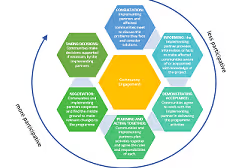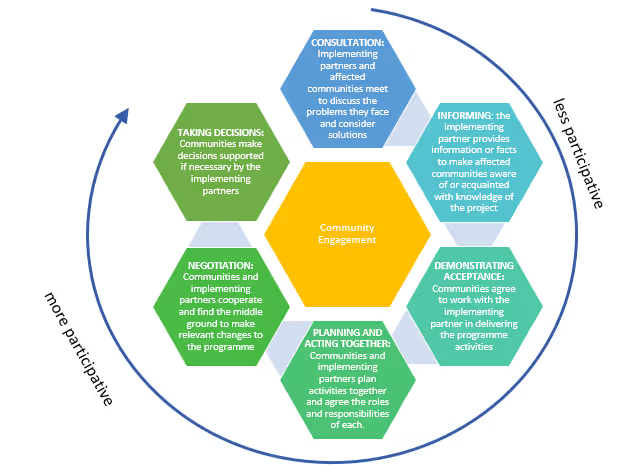Participation – The Foundation of User-Centred Design

What is participation?
Participation is the “buzz word” of the moment within the development sector, and with the development of the Core Humanitarian Standards on Quality and Accountability1, within the emergency sector it has been agreed that responses should be based on “communication, participation and feedback” as an essential element of a principled, accountable and high-quality humanitarian aid response.
However, dependent on the organisation or context you are working in, the definition of the word can vary greatly. To provide some sector wide clarity on the concept of participation, Sherry R. Arnstein created a simple tool that can be used in both evaluation and proactive planning of a project where participation is a critical element.
The model; a participation ladder, depicts levels of participation as rungs on a ladder, where the lowest rung of the ladder shows forms of “non-participation”, used by implementing partners to impose their agendas. The central rungs depict participation as tokenism; when communities hear about interventions and may say something about them, letting implementing partners classify this as “input’. What is key here however, is that the voices of the community do not have any significant influence on the intervention; their participation does not lead to change. Finally, at the highest rung of the ladder, participation is about communities having power to negotiate and change the status quo. Their voices are heard and can influence the change that they want to see.2
Why is community participation in emergencies important?
Community participation is vital to enhance user-centred design, ownership and control over decision-making processes, and therefore to making emergency responses much more effective. One of the main findings of the landscape review we carried out at the beginning of this project was that participation of the community in sanitation projects can often be restricted to the construction phase; where they are engaged as a paid labour force, or as a cash-for-work initiative. It is rarely used as it should be - to empower communities to influence the design and execution of the intervention; ensuring that people are not simply passive recipients of aid but are actively involved in problem solving, planning and decision-making, and as far as possible, are able to assume responsibility for programme process, facilities and services.
It is for this reason that we have chosen to explore the critical role of participation in user-centred design and as Research &; Evaluation partner, we will endeavour to explore the extent to which our communities were afforded the opportunity to participate in these Community Engagement for User-Centred Sanitation Design projects.
Making the ladder a circle
While the participation ladder was a great starting point for our discussions on how we would explore community participation in this project, it became apparent that we would need to adapt the model to reflect that in the context of an emergency response, steps can happen sequentially but also simultaneously if required (please see Diagram 1).

Bending that ladder into a circle with Community Engagement at the core, allowed us to visualise how six simple steps can be taken to ensure the affected communities are part of a collaborative process where they can help shape these sanitation programmes by combining their perspectives, knowledge, and experiences with those of the implementing partners.
The diagram illustrates several types of participation, with some being more participative than others, however it is our belief that with the inclusion of multiple participative actions in a Community Engagement intervention (either sequentially or simultaneously), user-centred design, and community ownership and control over decision-making processes will be enhanced; thereby making emergency responses more effective.
What’s Next?
In April and May we plan to travel to 2 of the 5 sites in this project to work with one of our implementing partners, to explore the extent to which our communities were afforded the opportunity to participate in these Community Engagement for User-Centred Sanitation Design projects. We will also be looking at how the communities participated and how our implementing partner responded to the participation (i.e. how the sanitation design options were altered as a result). Ultimately, we will be seeking to determine what the result was of this participation? Did it in fact lead to sanitation designs that reflect the needs and wants of the community which were provided in a timely manner and are appropriate, consistently used and community-owned.
Footnotes
- Core Humanitarian Standard Alliance (2018), https://corehumanitarianstandard.org/the-standard
- Arnstein, S. (1969) ‘A ladder of citizen participation’, Journal of the American Institute of Planners 35.4: 216–224
Stay updated
Sign up for our newsletter to receive regular updates on resources, news, and insights like this. Don’t miss out on important information that can help you stay informed and engaged.
Related articles



Explore Elrha
Learn more about our mission, the organisations we support, and the resources we provide to drive research and innovation in humanitarian response.